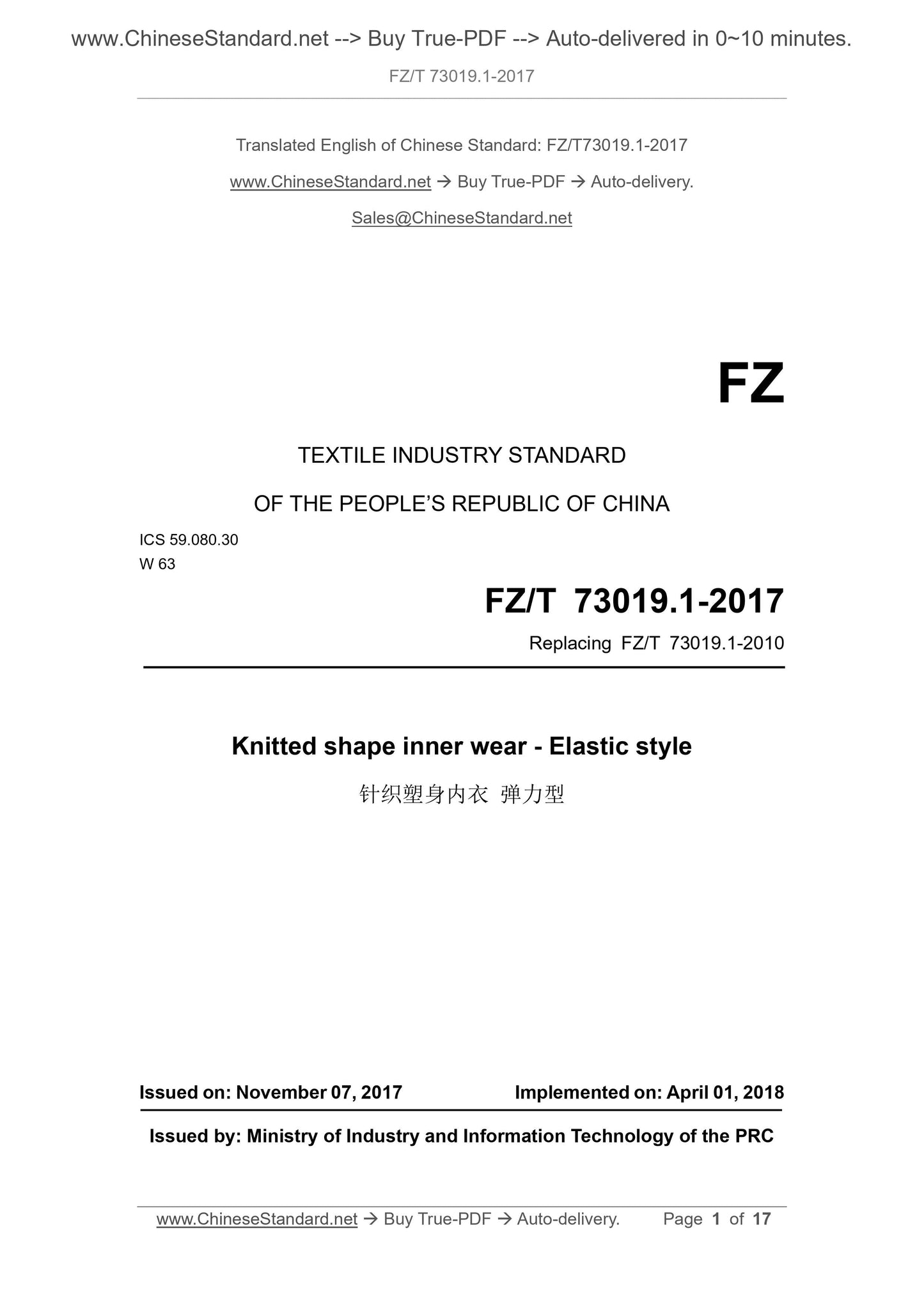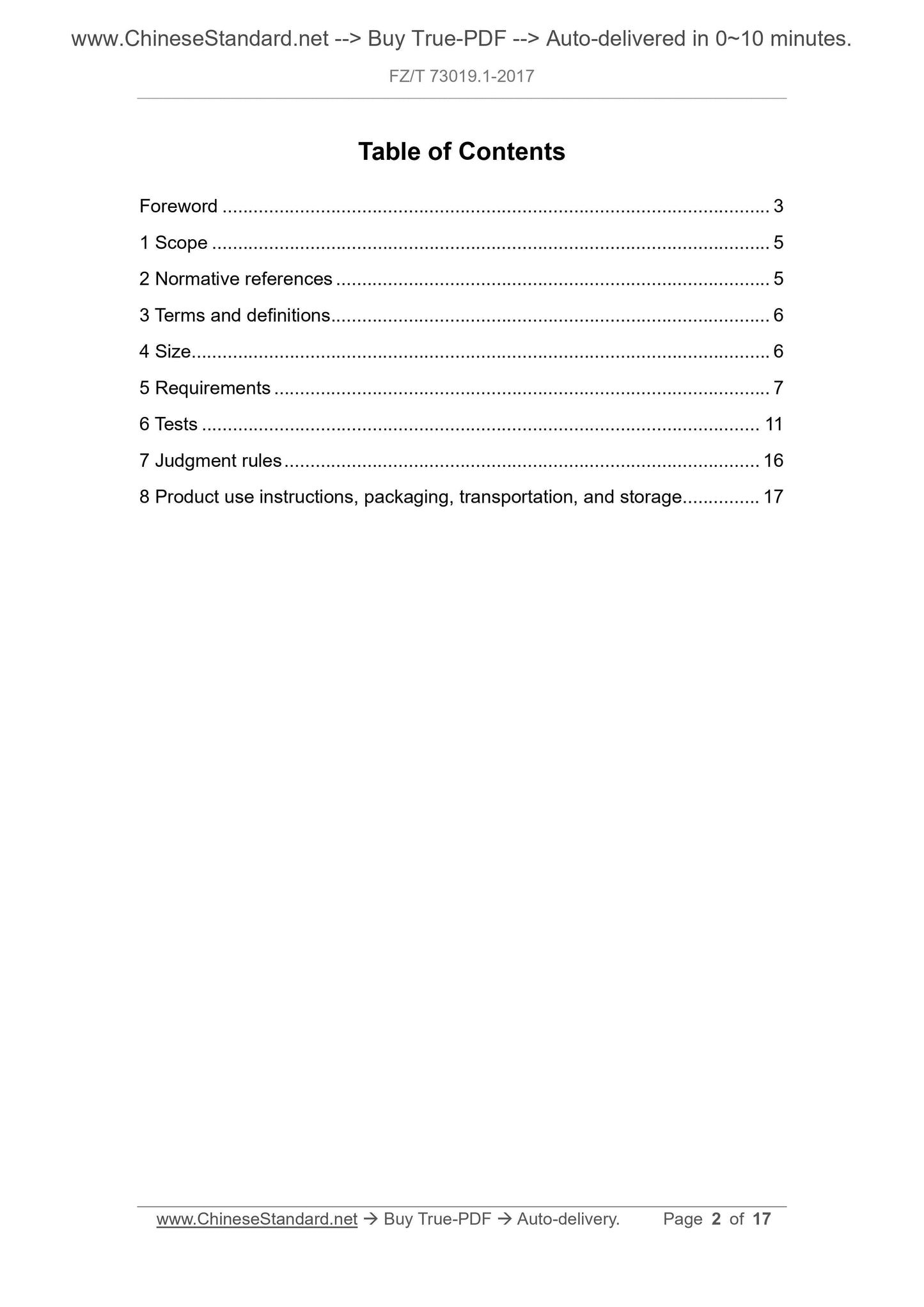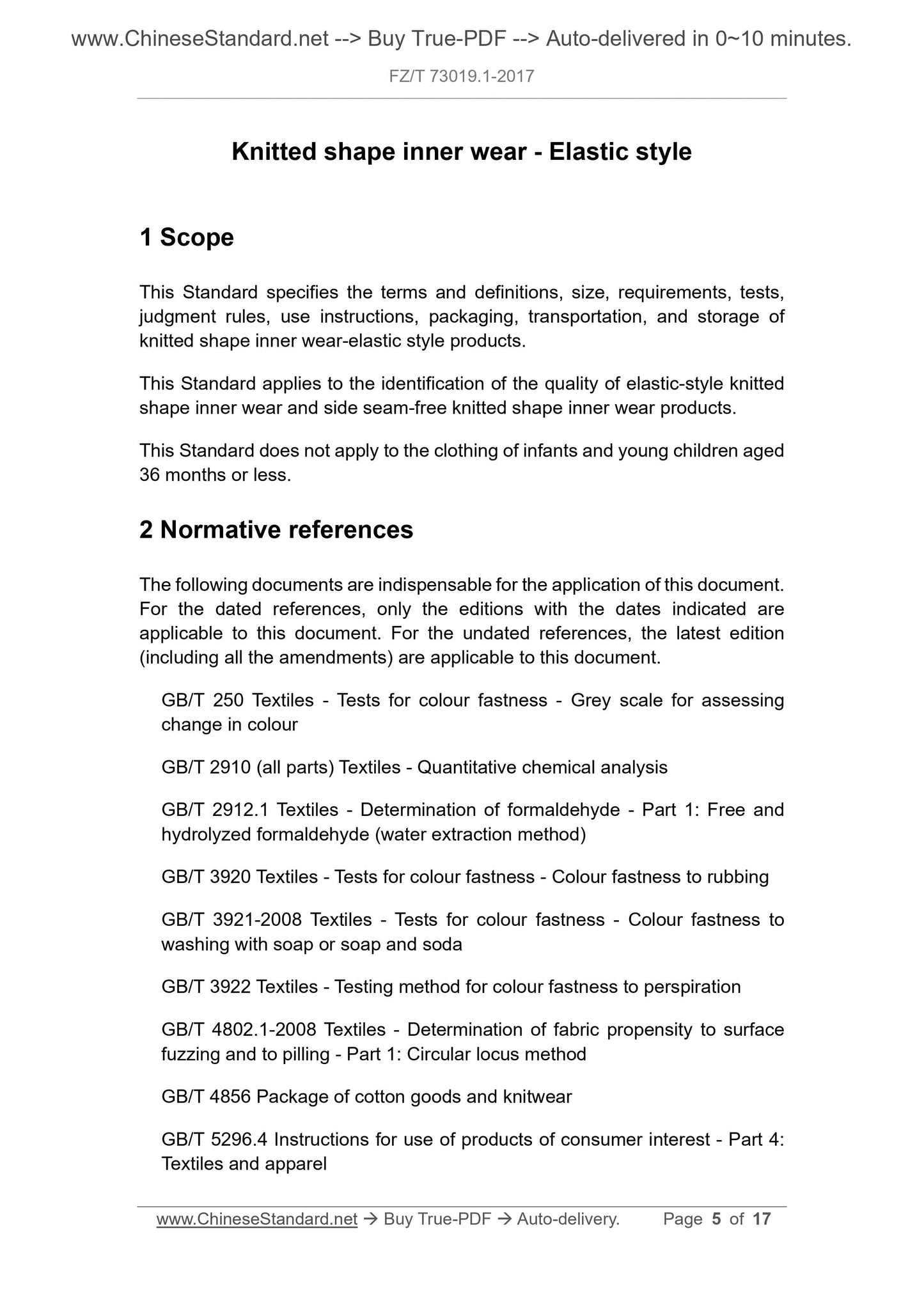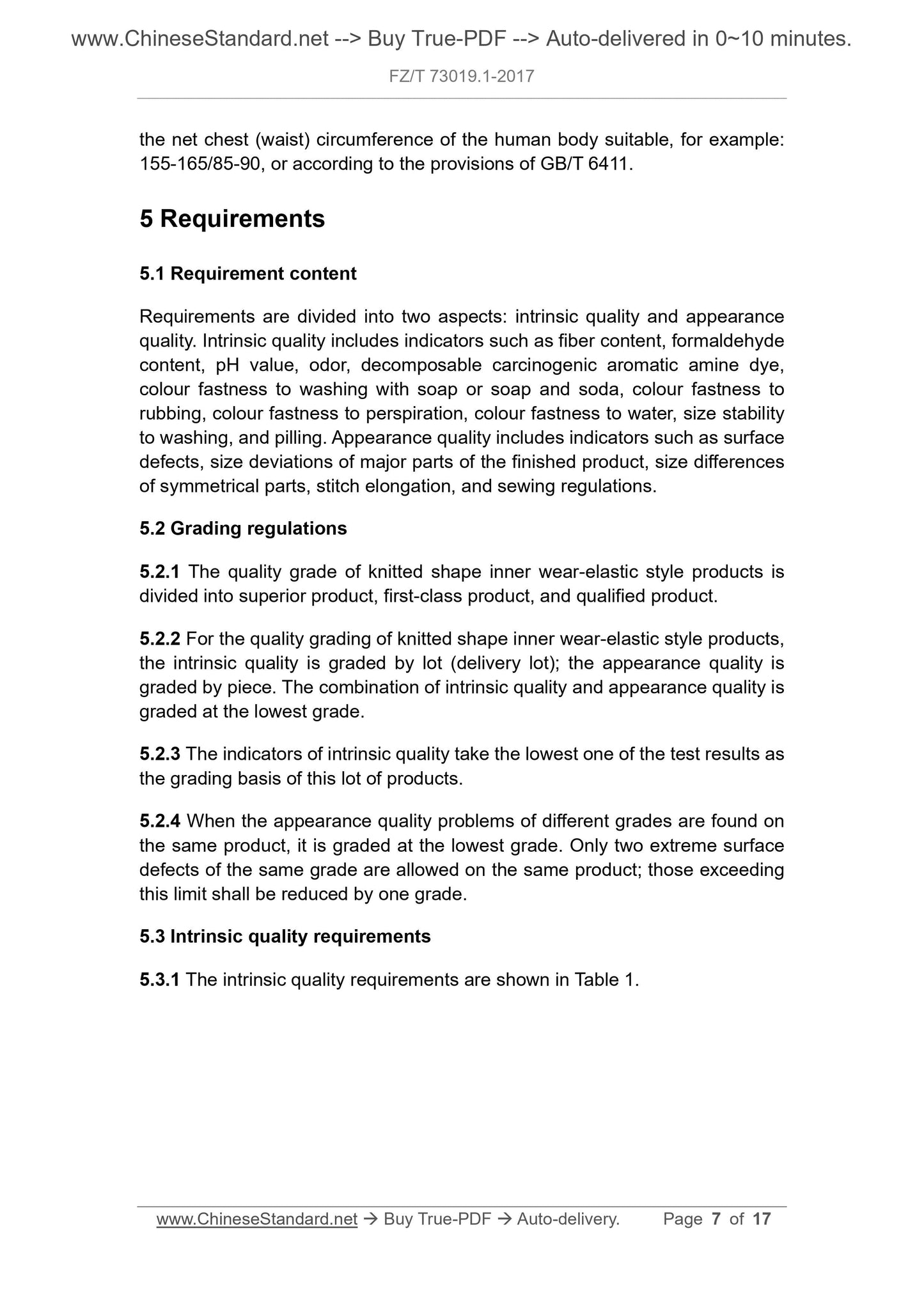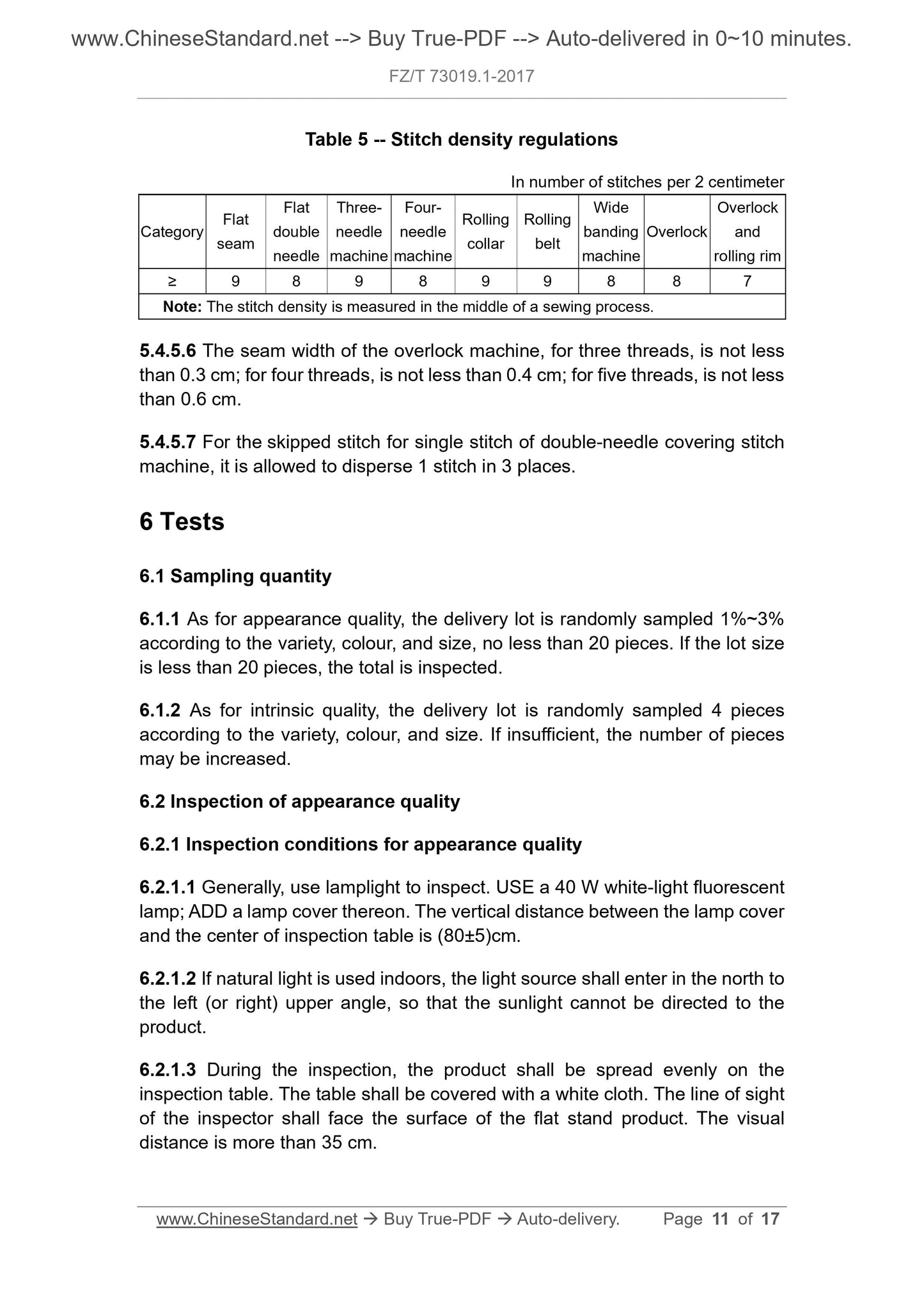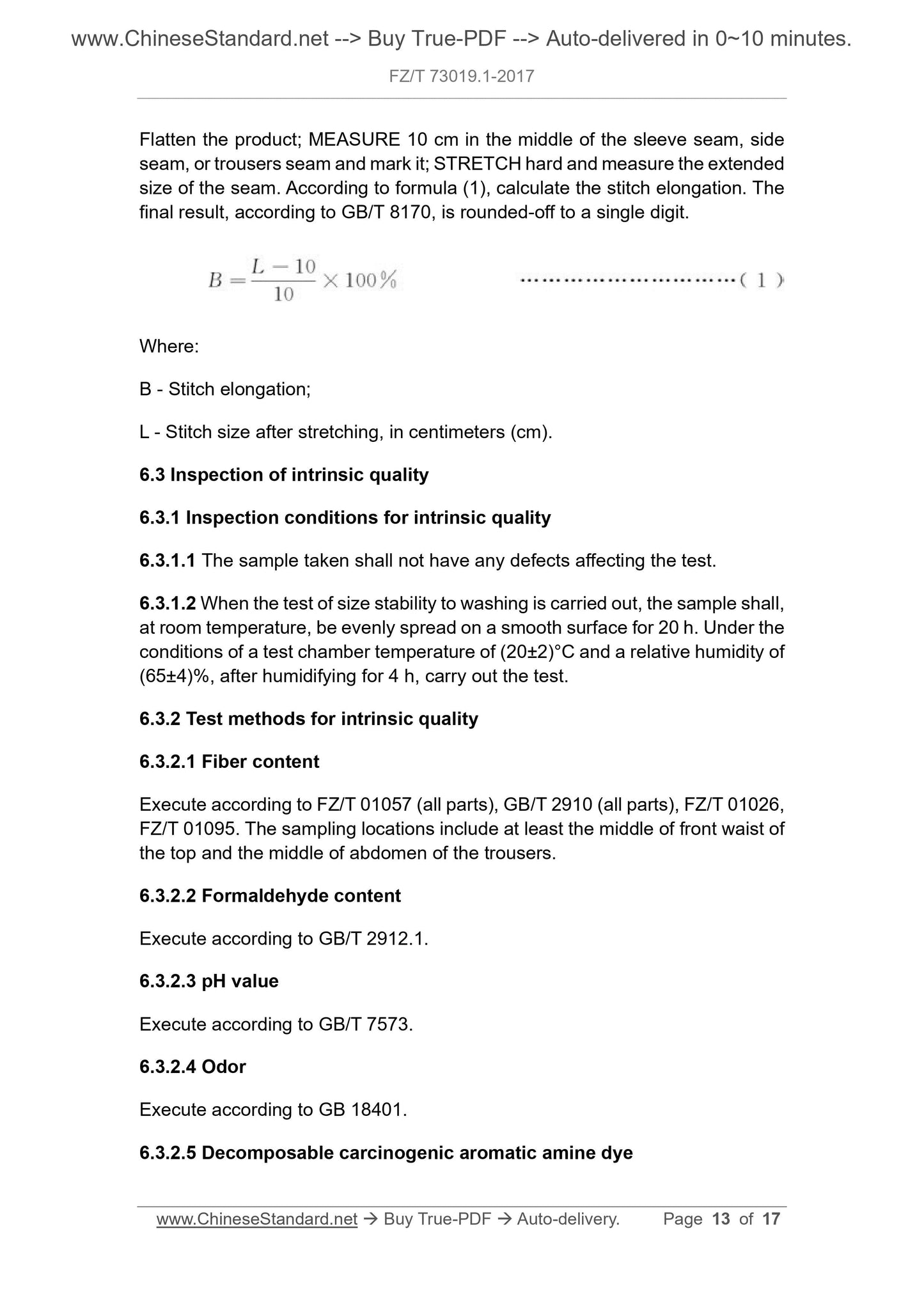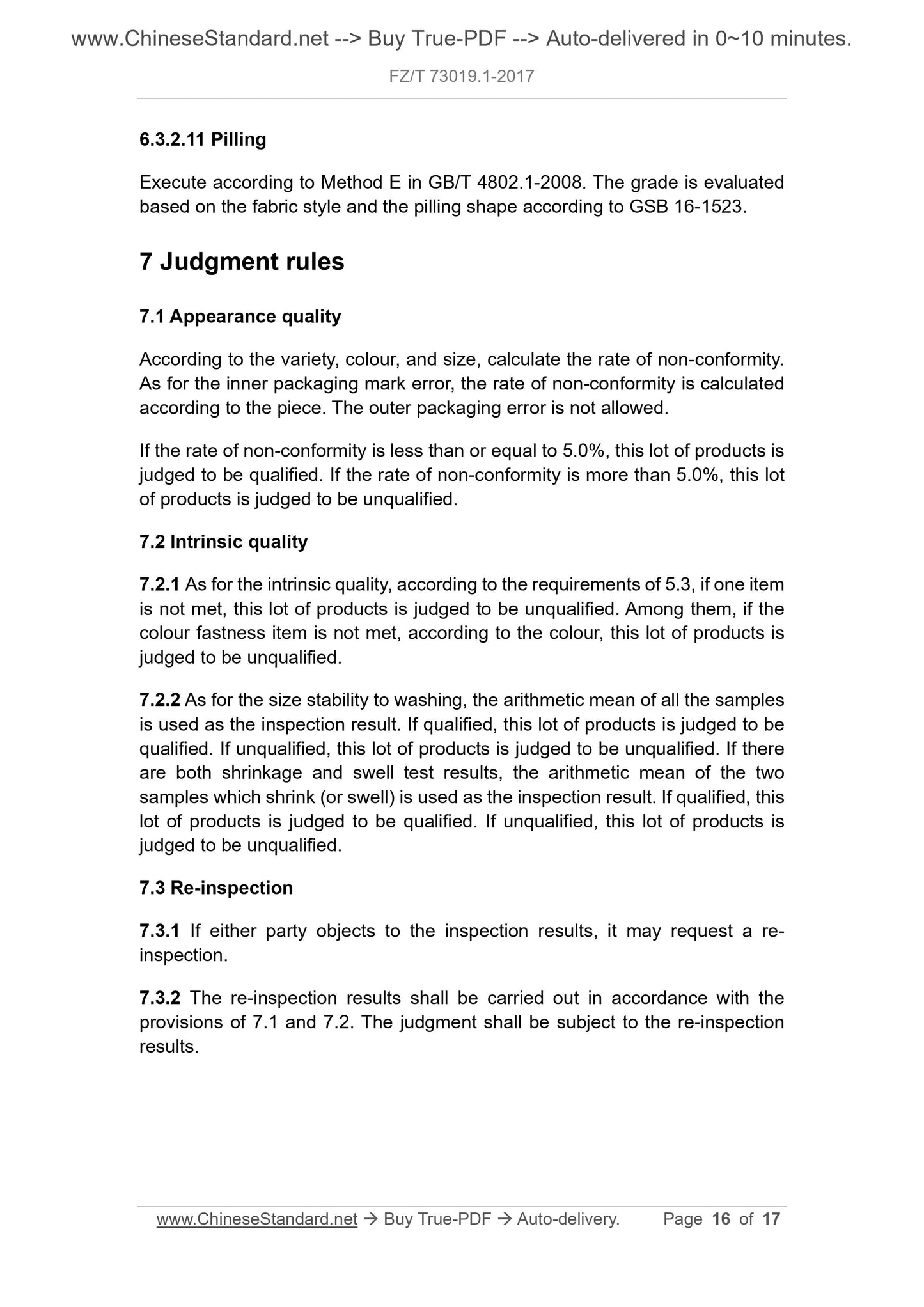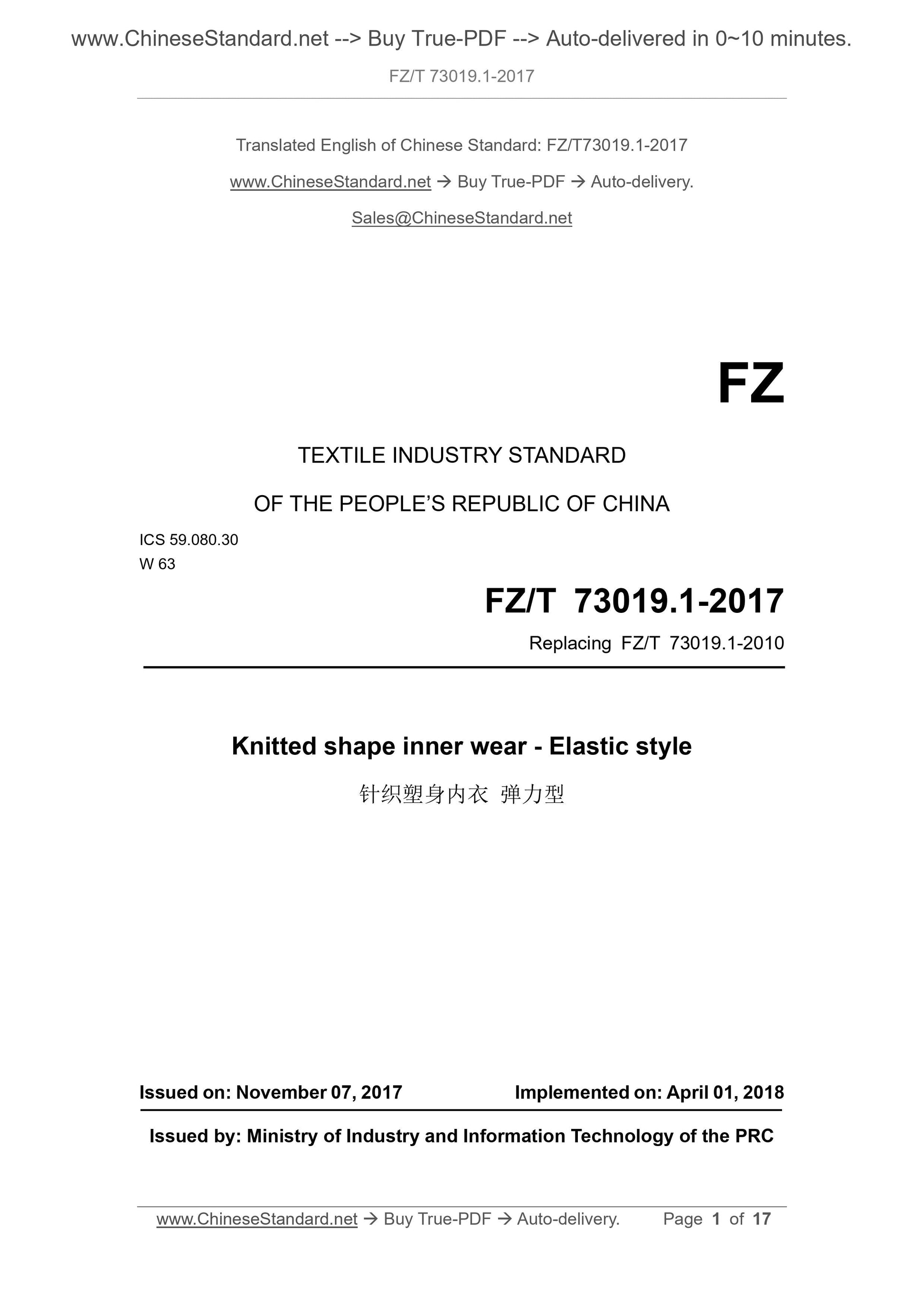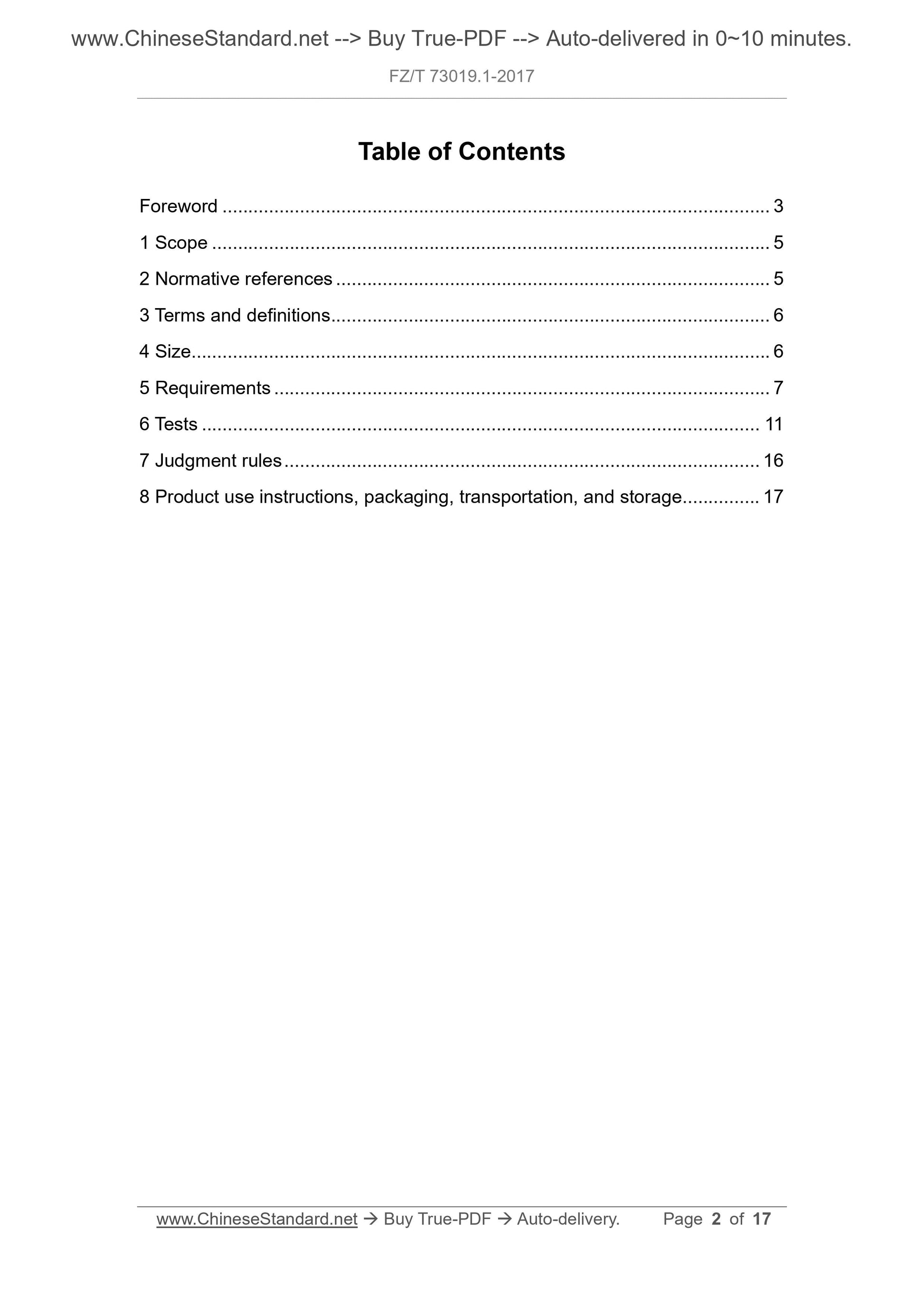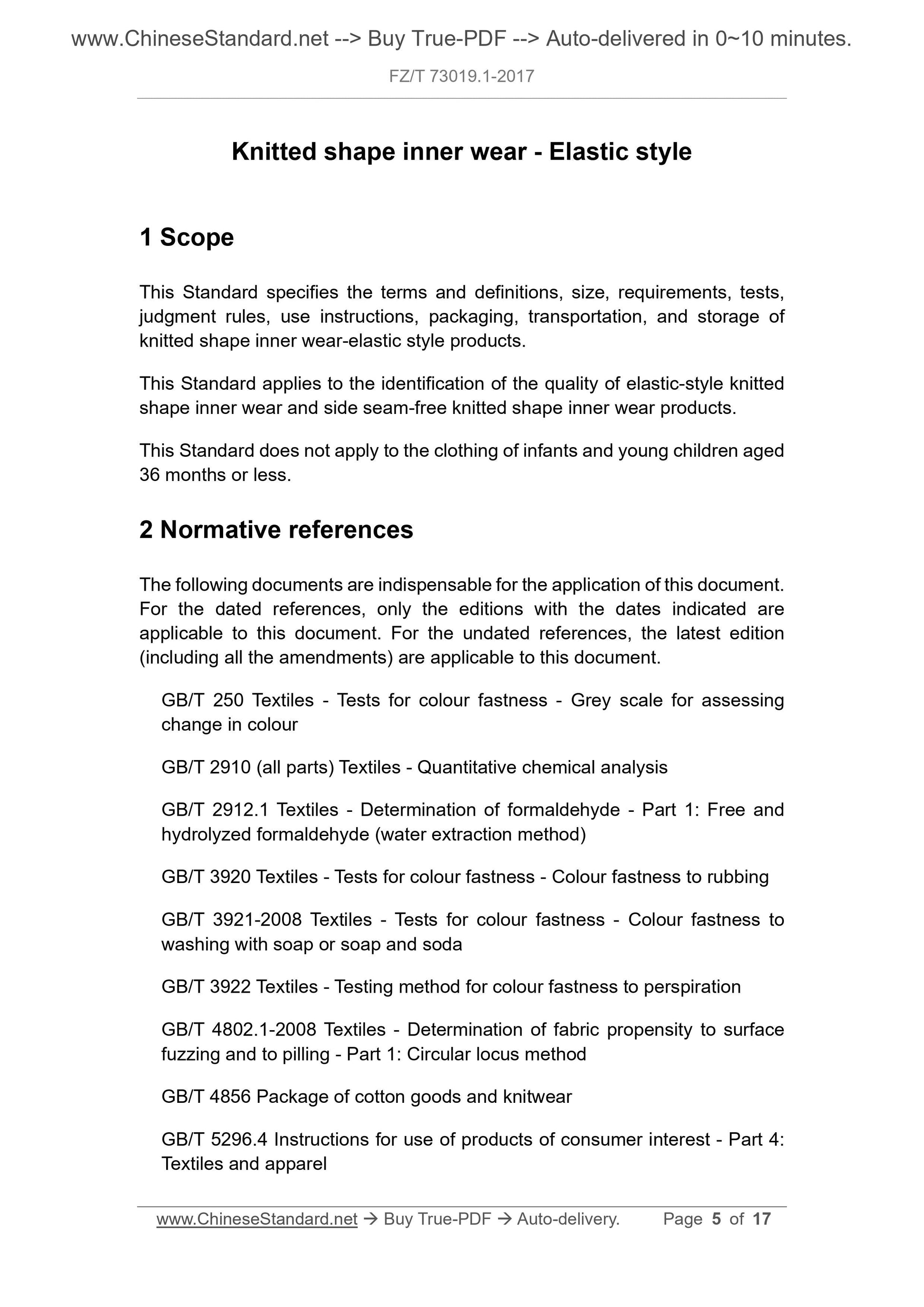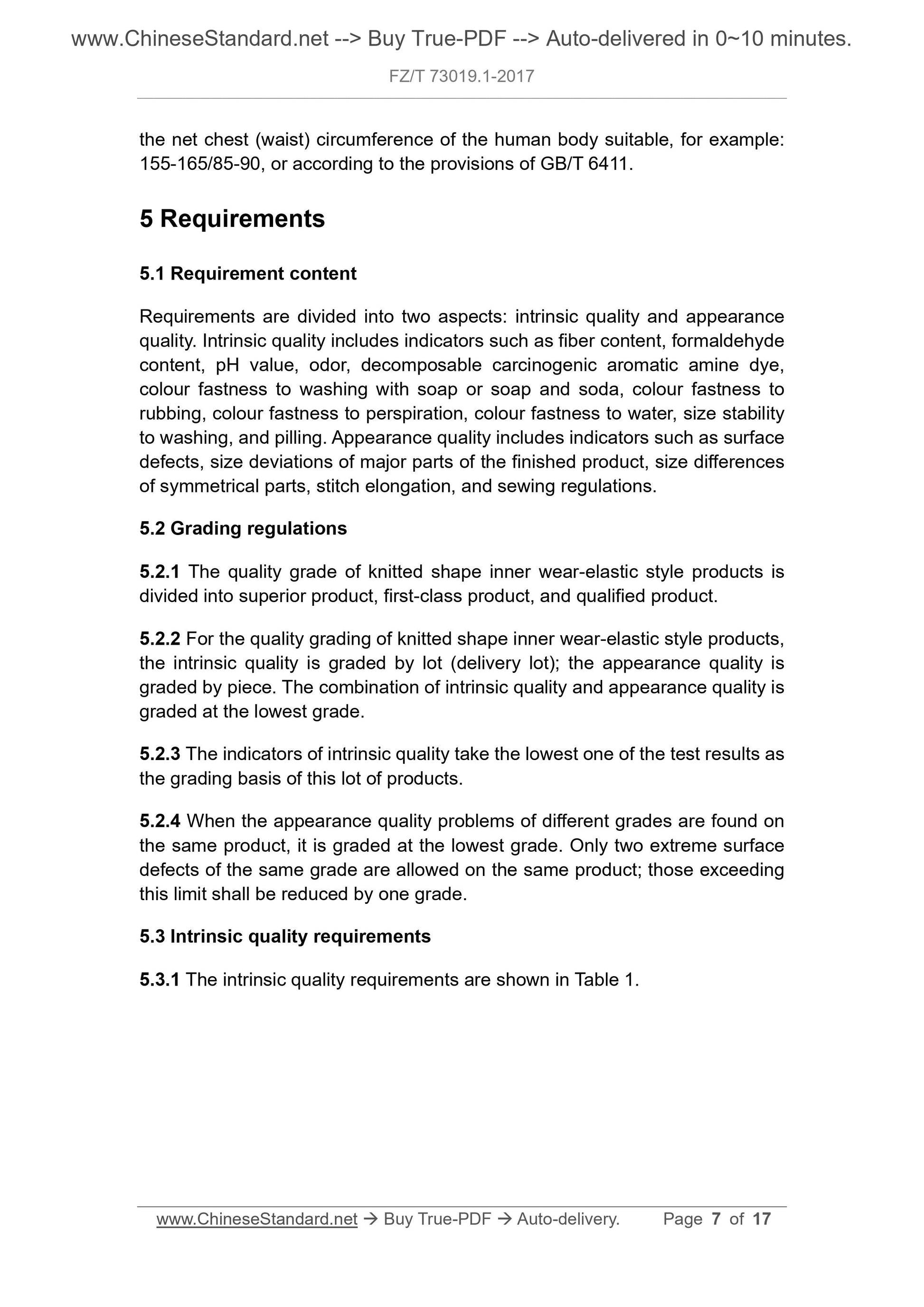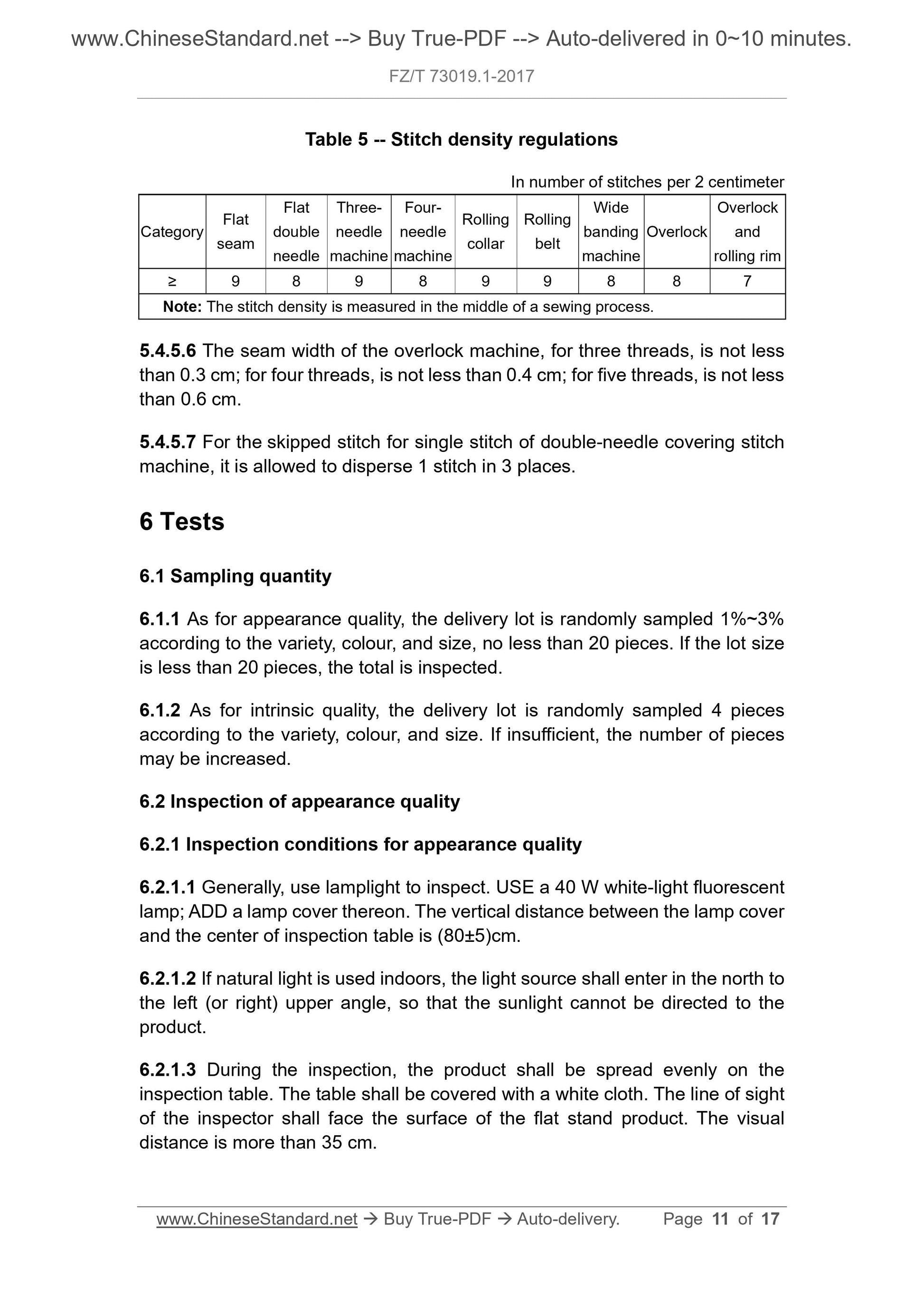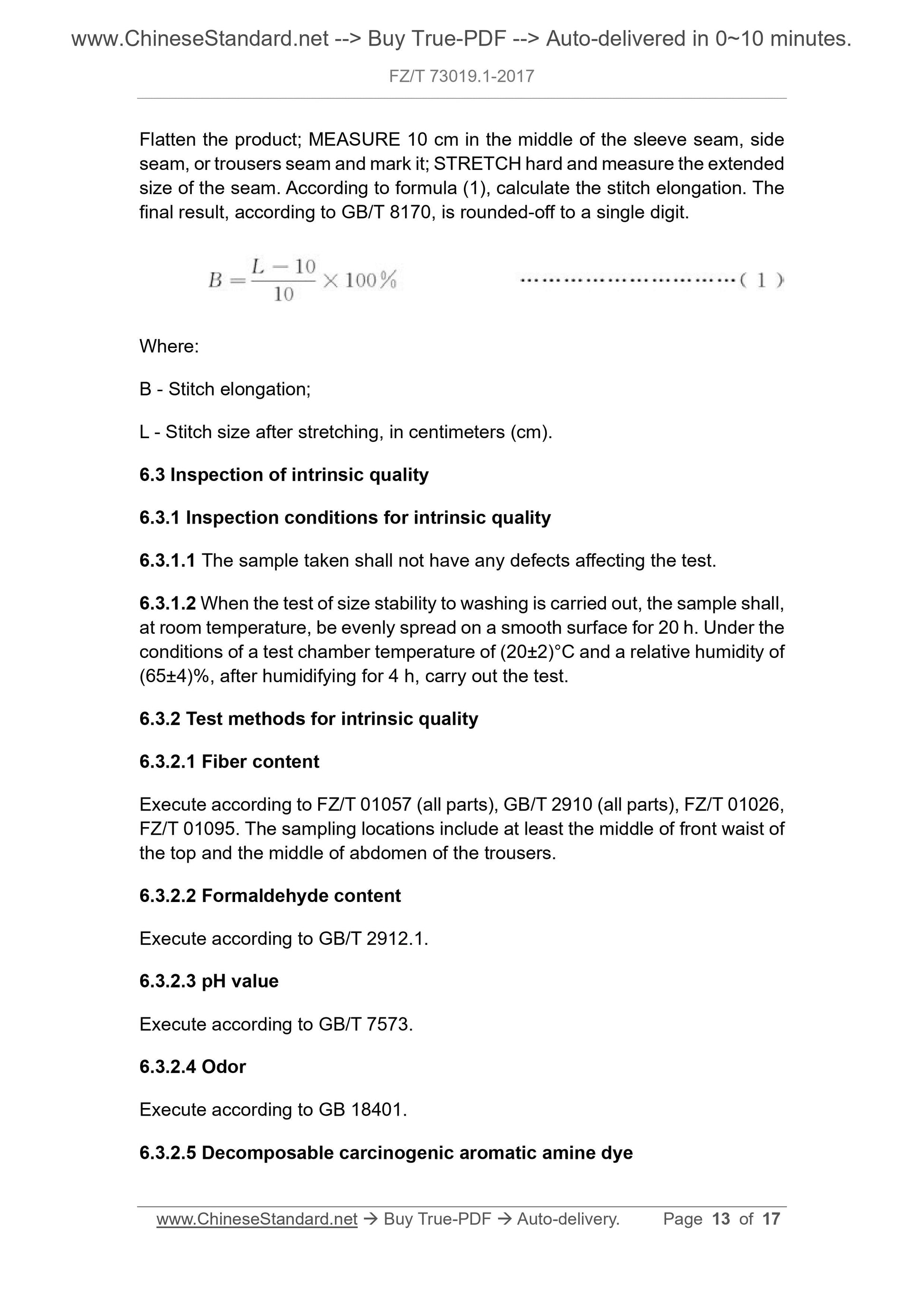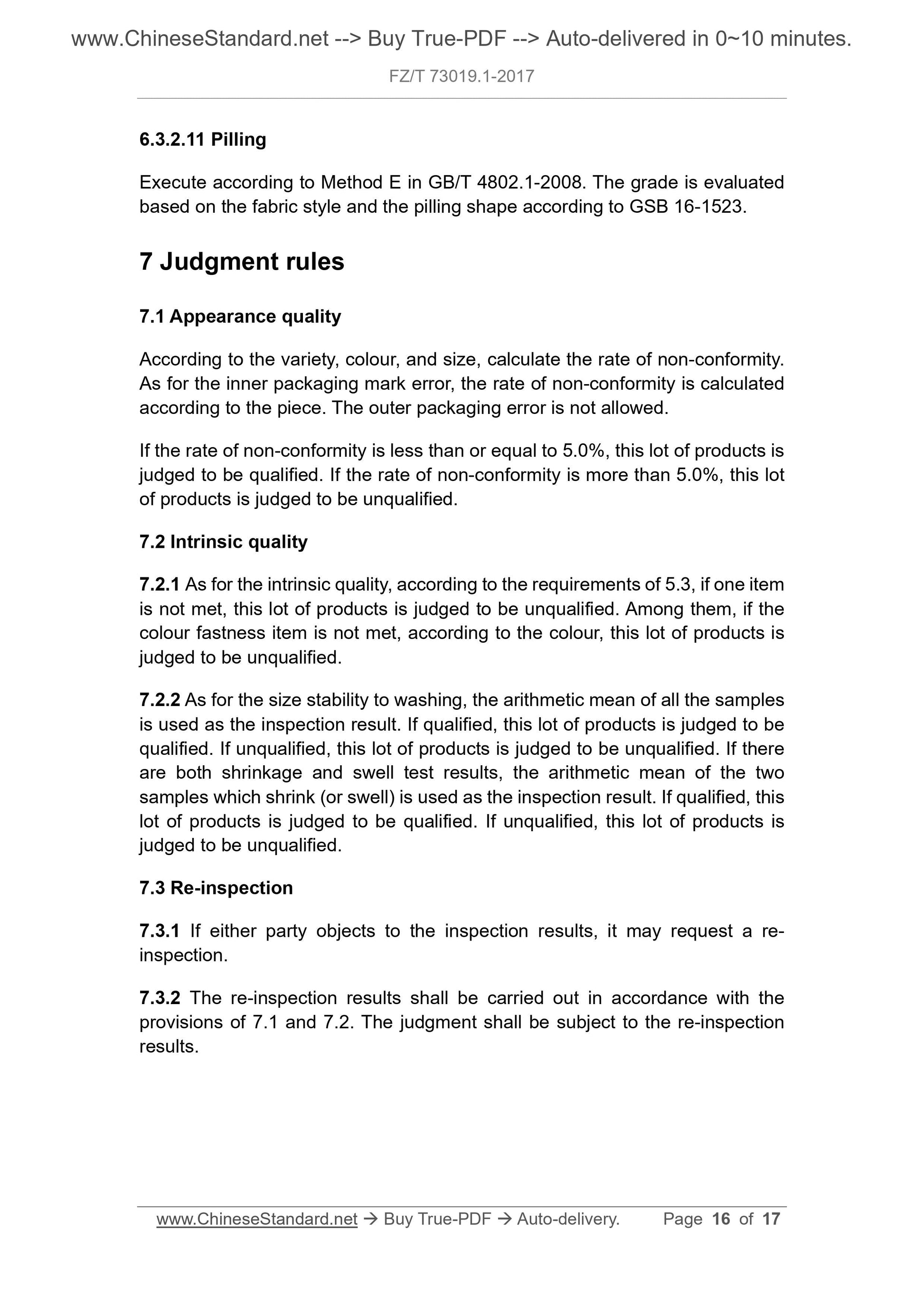1
/
von
7
PayPal, credit cards. Download editable-PDF and invoice in 1 second!
FZ/T 73019.1-2017 English PDF (FZT73019.1-2017)
FZ/T 73019.1-2017 English PDF (FZT73019.1-2017)
Normaler Preis
$120.00 USD
Normaler Preis
Verkaufspreis
$120.00 USD
Grundpreis
/
pro
Versand wird beim Checkout berechnet
Verfügbarkeit für Abholungen konnte nicht geladen werden
Delivery: 3 seconds. Download true-PDF + Invoice.
Get QUOTATION in 1-minute: Click FZ/T 73019.1-2017
Historical versions: FZ/T 73019.1-2017
Preview True-PDF (Reload/Scroll if blank)
FZ/T 73019.1-2017: Knitted shape inner wear. Elastic style
FZ/T 73019.1-2017
TEXTILE INDUSTRY STANDARD
OF THE PEOPLE’S REPUBLIC OF CHINA
ICS 59.080.30
W 63
Replacing FZ/T 73019.1-2010
Knitted shape inner wear - Elastic style
针织塑身内衣 弹力型
ISSUED ON: NOVEMBER 07, 2017
IMPLEMENTED ON: APRIL 01, 2018
Issued by: Ministry of Industry and Information Technology of the PRC
Table of Contents
Foreword ... 3
1 Scope ... 5
2 Normative references ... 5
3 Terms and definitions ... 6
4 Size... 6
5 Requirements ... 7
6 Tests ... 11
7 Judgment rules ... 16
8 Product use instructions, packaging, transportation, and storage ... 17
Knitted shape inner wear - Elastic style
1 Scope
This Standard specifies the terms and definitions, size, requirements, tests,
judgment rules, use instructions, packaging, transportation, and storage of
knitted shape inner wear-elastic style products.
This Standard applies to the identification of the quality of elastic-style knitted
shape inner wear and side seam-free knitted shape inner wear products.
This Standard does not apply to the clothing of infants and young children aged
36 months or less.
2 Normative references
The following documents are indispensable for the application of this document.
For the dated references, only the editions with the dates indicated are
applicable to this document. For the undated references, the latest edition
(including all the amendments) are applicable to this document.
GB/T 250 Textiles - Tests for colour fastness - Grey scale for assessing
change in colour
GB/T 2910 (all parts) Textiles - Quantitative chemical analysis
GB/T 2912.1 Textiles - Determination of formaldehyde - Part 1: Free and
hydrolyzed formaldehyde (water extraction method)
GB/T 3920 Textiles - Tests for colour fastness - Colour fastness to rubbing
GB/T 3921-2008 Textiles - Tests for colour fastness - Colour fastness to
washing with soap or soap and soda
GB/T 3922 Textiles - Testing method for colour fastness to perspiration
GB/T 4802.1-2008 Textiles - Determination of fabric propensity to surface
fuzzing and to pilling - Part 1: Circular locus method
GB/T 4856 Package of cotton goods and knitwear
GB/T 5296.4 Instructions for use of products of consumer interest - Part 4:
Textiles and apparel
the net chest (waist) circumference of the human body suitable, for example:
155-165/85-90, or according to the provisions of GB/T 6411.
5 Requirements
5.1 Requirement content
Requirements are divided into two aspects: intrinsic quality and appearance
quality. Intrinsic quality includes indicators such as fiber content, formaldehyde
content, pH value, odor, decomposable carcinogenic aromatic amine dye,
colour fastness to washing with soap or soap and soda, colour fastness to
rubbing, colour fastness to perspiration, colour fastness to water, size stability
to washing, and pilling. Appearance quality includes indicators such as surface
defects, size deviations of major parts of the finished product, size differences
of symmetrical parts, stitch elongation, and sewing regulations.
5.2 Grading regulations
5.2.1 The quality grade of knitted shape inner wear-elastic style products is
divided into superior product, first-class product, and qualified product.
5.2.2 For the quality grading of knitted shape inner wear-elastic style products,
the intrinsic quality is graded by lot (delivery lot); the appearance quality is
graded by piece. The combination of intrinsic quality and appearance quality is
graded at the lowest grade.
5.2.3 The indicators of intrinsic quality take the lowest one of the test results as
the grading basis of this lot of products.
5.2.4 When the appearance quality problems of different grades are found on
the same product, it is graded at the lowest grade. Only two extreme surface
defects of the same grade are allowed on the same product; those exceeding
this limit shall be reduced by one grade.
5.3 Intrinsic quality requirements
5.3.1 The intrinsic quality requirements are shown in Table 1.
Table 5 -- Stitch density regulations
In number of stitches per 2 centimeter
Category Flat seam
Flat
double
needle
Three-
needle
machine
Four-
needle
machine
Rolling
collar
Rolling
belt
Wide
banding
machine
Overlock
Overlock
and
rolling rim
≥ 9 8 9 8 9 9 8 8 7
Note: The stitch density is measured in the middle of a sewing process.
5.4.5.6 The seam width of the overlock machine, for three threads, is not less
than 0.3 cm; for four threads, is not less than 0.4 cm; for five threads, is not less
than 0.6 cm.
5.4.5.7 For the skipped stitch for single stitch of double-needle covering stitch
machine, it is allowed to disperse 1 stitch in 3 places.
6 Tests
6.1 Sampling quantity
6.1.1 As for appearance quality, the delivery lot is randomly sampled 1%~3%
according to the variety, colour, and size, no less than 20 pieces. If the lot size
is less than 20 pieces, the total is inspected.
6.1.2 As for intrinsic quality, the delivery lot is randomly sampled 4 pieces
according to the variety, colour, and size. If insufficient, the number of pieces
may be increased.
6.2 Inspection of appearance quality
6.2.1 Inspection conditions for appearance quality
6.2.1.1 Generally, use lamplight to inspect. USE a 40 W white-light fluorescent
lamp; ADD a lamp cover thereon. The vertical distance between the lamp cover
and the center of inspection table is (80±5)cm.
6.2.1.2 If natural light is used indoors, the light source shall enter in the north to
the left (or right) upper angle, so that the sunlight cannot be directed to the
product.
6.2.1.3 During the inspection, the product shall be spread evenly on the
inspection table. The table shall be covered with a white cloth. The line of sight
of the inspector shall face the surface of the flat stand product. The visual
distance is more than 35 cm.
Flatten the product; MEASURE 10 cm in the middle of the sleeve seam, side
seam, or trousers seam and mark it; STRETCH hard and measure the extended
size of the seam. According to formula (1), calculate the stitch elongation. The
final result, according to GB/T 8170, is rounded-off to a single digit.
Where:
B - Stitch elongation;
L - Stitch size after stretching, in centimeters (cm).
6.3 Inspection of intrinsic quality
6.3.1 Inspection conditions for intrinsic quality
6.3.1.1 The sample taken shall not have any defects affecting the test.
6.3.1.2 When the test of size stability to washing is carried out, the sample shall,
at room temperature, be evenly spread on a smooth surface for 20 h. Under the
conditions of a test chamber temperature of (20±2)°C and a relative humidity of
(65±4)%, after humidifying for 4 h, carry out the test.
6.3.2 Test methods for intrinsic quality
6.3.2.1 Fiber content
Execute according to FZ/T 01057 (all parts), GB/T 2910 (all parts), FZ/T 01026,
FZ/T 01095. The sampling locations include at least the middle of front waist of
the top and the middle of abdomen of the trousers.
6.3.2.2 Formaldehyde content
Execute according to GB/T 2912.1.
6.3.2.3 pH value
Execute according to GB/T 7573.
6.3.2.4 Odor
Execute according to GB 18401.
6.3.2.5 Decomposable carcinogenic aromatic amine dye
6.3.2.11 Pilling
Execute according to Method E in GB/T 4802.1-2008. The grade is evaluated
based on the fabric style and the pilling shape according to GSB 16-1523.
7 Judg...
Get QUOTATION in 1-minute: Click FZ/T 73019.1-2017
Historical versions: FZ/T 73019.1-2017
Preview True-PDF (Reload/Scroll if blank)
FZ/T 73019.1-2017: Knitted shape inner wear. Elastic style
FZ/T 73019.1-2017
TEXTILE INDUSTRY STANDARD
OF THE PEOPLE’S REPUBLIC OF CHINA
ICS 59.080.30
W 63
Replacing FZ/T 73019.1-2010
Knitted shape inner wear - Elastic style
针织塑身内衣 弹力型
ISSUED ON: NOVEMBER 07, 2017
IMPLEMENTED ON: APRIL 01, 2018
Issued by: Ministry of Industry and Information Technology of the PRC
Table of Contents
Foreword ... 3
1 Scope ... 5
2 Normative references ... 5
3 Terms and definitions ... 6
4 Size... 6
5 Requirements ... 7
6 Tests ... 11
7 Judgment rules ... 16
8 Product use instructions, packaging, transportation, and storage ... 17
Knitted shape inner wear - Elastic style
1 Scope
This Standard specifies the terms and definitions, size, requirements, tests,
judgment rules, use instructions, packaging, transportation, and storage of
knitted shape inner wear-elastic style products.
This Standard applies to the identification of the quality of elastic-style knitted
shape inner wear and side seam-free knitted shape inner wear products.
This Standard does not apply to the clothing of infants and young children aged
36 months or less.
2 Normative references
The following documents are indispensable for the application of this document.
For the dated references, only the editions with the dates indicated are
applicable to this document. For the undated references, the latest edition
(including all the amendments) are applicable to this document.
GB/T 250 Textiles - Tests for colour fastness - Grey scale for assessing
change in colour
GB/T 2910 (all parts) Textiles - Quantitative chemical analysis
GB/T 2912.1 Textiles - Determination of formaldehyde - Part 1: Free and
hydrolyzed formaldehyde (water extraction method)
GB/T 3920 Textiles - Tests for colour fastness - Colour fastness to rubbing
GB/T 3921-2008 Textiles - Tests for colour fastness - Colour fastness to
washing with soap or soap and soda
GB/T 3922 Textiles - Testing method for colour fastness to perspiration
GB/T 4802.1-2008 Textiles - Determination of fabric propensity to surface
fuzzing and to pilling - Part 1: Circular locus method
GB/T 4856 Package of cotton goods and knitwear
GB/T 5296.4 Instructions for use of products of consumer interest - Part 4:
Textiles and apparel
the net chest (waist) circumference of the human body suitable, for example:
155-165/85-90, or according to the provisions of GB/T 6411.
5 Requirements
5.1 Requirement content
Requirements are divided into two aspects: intrinsic quality and appearance
quality. Intrinsic quality includes indicators such as fiber content, formaldehyde
content, pH value, odor, decomposable carcinogenic aromatic amine dye,
colour fastness to washing with soap or soap and soda, colour fastness to
rubbing, colour fastness to perspiration, colour fastness to water, size stability
to washing, and pilling. Appearance quality includes indicators such as surface
defects, size deviations of major parts of the finished product, size differences
of symmetrical parts, stitch elongation, and sewing regulations.
5.2 Grading regulations
5.2.1 The quality grade of knitted shape inner wear-elastic style products is
divided into superior product, first-class product, and qualified product.
5.2.2 For the quality grading of knitted shape inner wear-elastic style products,
the intrinsic quality is graded by lot (delivery lot); the appearance quality is
graded by piece. The combination of intrinsic quality and appearance quality is
graded at the lowest grade.
5.2.3 The indicators of intrinsic quality take the lowest one of the test results as
the grading basis of this lot of products.
5.2.4 When the appearance quality problems of different grades are found on
the same product, it is graded at the lowest grade. Only two extreme surface
defects of the same grade are allowed on the same product; those exceeding
this limit shall be reduced by one grade.
5.3 Intrinsic quality requirements
5.3.1 The intrinsic quality requirements are shown in Table 1.
Table 5 -- Stitch density regulations
In number of stitches per 2 centimeter
Category Flat seam
Flat
double
needle
Three-
needle
machine
Four-
needle
machine
Rolling
collar
Rolling
belt
Wide
banding
machine
Overlock
Overlock
and
rolling rim
≥ 9 8 9 8 9 9 8 8 7
Note: The stitch density is measured in the middle of a sewing process.
5.4.5.6 The seam width of the overlock machine, for three threads, is not less
than 0.3 cm; for four threads, is not less than 0.4 cm; for five threads, is not less
than 0.6 cm.
5.4.5.7 For the skipped stitch for single stitch of double-needle covering stitch
machine, it is allowed to disperse 1 stitch in 3 places.
6 Tests
6.1 Sampling quantity
6.1.1 As for appearance quality, the delivery lot is randomly sampled 1%~3%
according to the variety, colour, and size, no less than 20 pieces. If the lot size
is less than 20 pieces, the total is inspected.
6.1.2 As for intrinsic quality, the delivery lot is randomly sampled 4 pieces
according to the variety, colour, and size. If insufficient, the number of pieces
may be increased.
6.2 Inspection of appearance quality
6.2.1 Inspection conditions for appearance quality
6.2.1.1 Generally, use lamplight to inspect. USE a 40 W white-light fluorescent
lamp; ADD a lamp cover thereon. The vertical distance between the lamp cover
and the center of inspection table is (80±5)cm.
6.2.1.2 If natural light is used indoors, the light source shall enter in the north to
the left (or right) upper angle, so that the sunlight cannot be directed to the
product.
6.2.1.3 During the inspection, the product shall be spread evenly on the
inspection table. The table shall be covered with a white cloth. The line of sight
of the inspector shall face the surface of the flat stand product. The visual
distance is more than 35 cm.
Flatten the product; MEASURE 10 cm in the middle of the sleeve seam, side
seam, or trousers seam and mark it; STRETCH hard and measure the extended
size of the seam. According to formula (1), calculate the stitch elongation. The
final result, according to GB/T 8170, is rounded-off to a single digit.
Where:
B - Stitch elongation;
L - Stitch size after stretching, in centimeters (cm).
6.3 Inspection of intrinsic quality
6.3.1 Inspection conditions for intrinsic quality
6.3.1.1 The sample taken shall not have any defects affecting the test.
6.3.1.2 When the test of size stability to washing is carried out, the sample shall,
at room temperature, be evenly spread on a smooth surface for 20 h. Under the
conditions of a test chamber temperature of (20±2)°C and a relative humidity of
(65±4)%, after humidifying for 4 h, carry out the test.
6.3.2 Test methods for intrinsic quality
6.3.2.1 Fiber content
Execute according to FZ/T 01057 (all parts), GB/T 2910 (all parts), FZ/T 01026,
FZ/T 01095. The sampling locations include at least the middle of front waist of
the top and the middle of abdomen of the trousers.
6.3.2.2 Formaldehyde content
Execute according to GB/T 2912.1.
6.3.2.3 pH value
Execute according to GB/T 7573.
6.3.2.4 Odor
Execute according to GB 18401.
6.3.2.5 Decomposable carcinogenic aromatic amine dye
6.3.2.11 Pilling
Execute according to Method E in GB/T 4802.1-2008. The grade is evaluated
based on the fabric style and the pilling shape according to GSB 16-1523.
7 Judg...
Share
